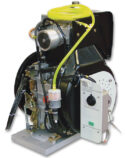Experiment
TD211
MODIFIED 4 STROKE PETROL ENGINE
A four-stoke single-cylinder petrol engine with modified cylinder head and crank for use with TecQuipment's TD200 Small Engine Test Set.
If you have any questions or you'd like to discuss a product, please call us.
+44 1159 722 611MODIFIED 4 STROKE PETROL ENGINE
High-quality and cost-effective four-stroke, single-cylinder petrol engine for use with TecQuipment’s Small Engine Test Set (TD200). Adapted specially for education to enable effective laboratory testing and demonstrations, the engine includes an exhaust thermocouple, a half-coupling to link to the test set dynamometer and all essential hoses and fittings. In addition, each engine includes a colourcoded fuel tank with self-sealing couplings. The couplings ensure the engines can be connected and disconnected quickly and efficiently with minimum loss or spillage of fuel. For convenience and safety, the fuel tank can be removed for filling or for storage in a fuel locker when not in use. Removing the fuel tank also prevents unauthorised use of the equipment.
The engine has a modified cylinder head and crank. These allow use with the Cylinder Head Pressure Transducer (ECA101 available separately) and the Crank Angle Encoder (EA102 available separately). These can then connect to the Engine Cycle Analyser (ECA100 available separately) to extend the range of experiments possible. The engine is mounted on a sturdy precision bedplate. The bedplate has dowels and slots which align and locate it accurately with the dynamometer test set. This minimises the time spent replacing one engine with another.
This engine starts using a simple pull cord, but TecQuipment can supply an electric start version (TD211ES). Contact our sales team for details.
Learning outcomes
When used with TecQuipment’s Small Engine Test Set (TD200), investigations into the performance and characteristics of a four-stroke petrol engine, including:
- Torque, speed and power relationship
- Brake mean effective pressure
- Engine performance curves
- Air and fuel consumption
- Volumetric and thermal efficiencies - When used with TecQuipment’s Small Engine Test Set (TD200), Cylinder Head Pressure Transducer (ECA101), Crank Angle Encoder (ECA102) and Engine Cycle Analyser (ECA100), students can investigate further features including:
- Plotting p-θ and p-V diagrams
- Engine cycle analysis
- Indicated mean effective pressure
- Indicated power
- Comparison of brake and indicated mean effective pressures
- Mechanical efficiency of the engine







